The 22 Winchester Magnum Rimfire has enjoyed steady popularity since its introduction 65 years ago. The 22 WMR, or 22 Magnum, is a crackerjack cartridge that increases the range and killing power of a rimfire firearm. The cartridge differs considerably from the 22 Long Rifle. The hoary old 22 LR features a lead heel-based bullet pressed into the case. The 22 Magnum features a jacketed bullet crimped into the cartridge case. This makes the Magnum much more feed reliable. The 22 Magnum has been adapted to revolvers easily, but the cartridge has not been chambered in self-loading pistols as seamlessly. A rimmed cartridge case presents a design hurdle. Most 22 Magnum loads are designed for rifles and use slower-burning powder, with the Hornady Critical Defense round used in this test being an exception. As a result, the cartridges often leave considerable powder residue.
Three modern handguns we tested in this chambering recently were the KelTec PMR-30 PMR30TACGY in Tactical Grey coloring, $490; the Rock Island Armory XT 22 51996, $503; and the Walther WMP (Walther Magnum Pistol) 5220300, $549. All make claim to perfect reliability and good accuracy. They actually came very close, but only one exhibited perfect reliability.
How We Tested
We expanded the test program over our usual two to four loads. We usually use some type of FMJ loading for practice and a hollow point to confirm feed reliability, then proceed to a mix of three loads for accuracy testing from a benchrest. We used a total of 10 loads during this test. The loads used are listed in the Velocity Table as a point of interest, as well as the usual Range Data.
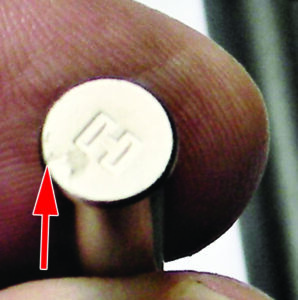
We wanted to test reliability with inexpensive FMJ loads, which are usually more lightly loaded, to the most potent loads and high-velocity offerings with 30-grain bullets as well as heavier 45-grain class loads. We used six CCI, one Winchester, one Armscor, and two Hornady loads. We also included some results from a 6½-inch-barrel revolver we recently tested for comparison, and, finally, we chronographed a rifle using 22 Magnum loads. The self-loading handguns generate significantly greater velocity than revolvers, we found. Handguns and velocity with high-intensity loads are unpredictable, and while similar handguns may post similar velocities, it isn’t always a given. The Walther seemed to generate the highest velocity with most loads, but then the Rock gave a 92-fps boost over the Walther with one load — from the same box of ammunition used to test the Walther. The Walther definitely generates more velocity than most revolvers. The revolvers tested with 22 Magnum loads were 6½-inch barrel handguns, the longest practical field length. As one rater noted, he will retire his Ruger Single Six from small-game hunting in favor of the Walther. The Walther, he feels, is like a rifle on the hip. All agree that in a pinch the 22 Magnum could be a life saver if you can shoot well, much more so than a revolver with only six rounds on tap.
All three makers stress properly loading the magazines is important for 22 Magnum feed reliability. We used the same drill when loading all three pistols. We slipped the long cartridges under the feed lips, and after loading three rounds, we tapped the back of the magazine to seat the cartridges fully to the rear. We also did not lower the follower to its lowest point and drop cartridges in. We pressed them in one at a time. The Walther WMP’s polymer magazine is easily loaded to full capacity, the best of the test in that regard, despite its lower round count.
The power of the cartridge, while respectable, isn’t something we recommend for personal defense, but we recognize many shooters will consider these guns for self defense regardless. Their better use, in our view, is as a field gun for small game and protection against feral dogs and bobcat-size pests. It compares well against the 32 H&R Magnum or 380 ACP for the recoil shy. The bottom line must be reliability, and the design of the cartridge itself is a problem. Rimfire cartridges are notorious for the occasional failure to ignite the priming compound. We ran a thorough test of the three guns with nine types of 22 Magnum ammunition for a total of 800 cartridges, spread out as evenly as possible among the three handguns. We liked all of the guns, but one had troubling function problems. Another was a bit large for most hand sizes. But one of this trio we recommend wholeheartedly, for the reasons we list below.
Gun Tests Grade: B
$503
As tested with an additional magazine we bought separately and a Wilson Combat Slide Lock, the total comes to $614. The Rock Island XT 22 is geared toward 1911 fans. It looks like a 1911, handles the same, and offers a fine understudy to the 1911 45 ACP handgun. Rock Island made the necessary engineering changes to adapt the 1911 action to the 22 Magnum cartridge. Arguably, the XT 22 is more similar to a 1911 with a 22 LR conversion unit than a true 1911 handgun.
| Action Type | Double action |
| Overall Length | 8.5 in. |
| Overall Height | 5.1 in. |
| Maximum Width | 1.3 in. |
| Weight Unloaded | 40.0 oz. |
| Weight Loaded | 42.0 oz. |
| Slide | Parkerized steel |
| Slide Retraction Effort | 15.0 lbs. |
| Receiver | Parkerized steel |
| Front Strap Height | 3.2 in. |
| Rear Strap Height | 2.6 in. |
| Barrel Length | 5.0 in. |
| Grip Panels | Changeable rubber |
| Grip Thickness | 1.25 in. |
| Grip Circumference | 5.2 in. |
| Magazine | (1) 14 round |
| Rear Sight | Fixed steel |
| Front Sight | Fiber optic |
| Trigger Pull Weight | 5.25 lbs. |
| Trigger Span | 2.8 in. |
| Sight Radius | 6.4 in. |
| Safety | Trigger lever |
| Warranty | Limited Lifetime |
| Telephone | (775) 537-1444 |
| Website | Armscor.com |
| Made In | Philippines |
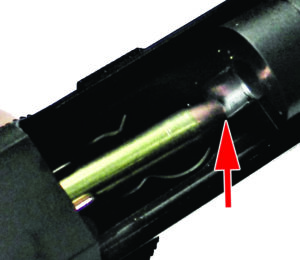
The most obvious departure from the 1911 is an open-top slide. This makes for a lighter top end and allows easier redesign to a blowback operation. The barrel with the chamber and feedway are morphed into an outer barrel shroud. The barrel is actually spring loaded by means of a plunger in the shroud near the bottom rear of the barrel shroud. There is movement between the pieces on firing, but somehow the system works well. Because the slide and frame are steel, the pistol has a balance identical to a Government Model 1911 45, but the weight also makes it the heaviest pistol tested at a hefty 40 ounces. Recoil isn’t a consideration with heavier guns, and clearly the XT 22 has no recoil to speak of.

The hammer and trigger are designed to look like the 1911 and function in the same manner. The trigger has an adjustable trigger stop. The pistol features a slide-lock safety and a standard 1911-type grip safety. The grip safety locks the trigger in place until the safety is depressed about halfway into its travel. The slide-lock safety is positive in operation, moving into position with a sharp snap. The mainspring housing is nicely checkered. We have seen advertisements with different styles of grip panels. Our pistol featured simple rubber grips. The slide stop and magazine release are standard 1911. All controls operate in a positive manner. The extractor is robust in design. The cocking serrations offer good leverage. The front sight is fiber optic, and the rear sight offers windage adjustment.
Field strip isn’t particularly complicated. Be certain the pistol is unloaded and lock the slide to the rear. The slide stop is pressed out right to left. The slide is run forward off the frame. The slide was somewhat difficult to run off the frame, catching tight at the end of travel. The recoil spring is pinched and held forward to remove the barrel. The inner barrel easily slides out of the shroud for cleaning. While there were no issues related to the barrel shroud design, the 22 Magnum left a good portion of unburned powder in all the pistols during the test. The Rock Island XT 22 design may tend to trap more powder ash than the other pistols. Be careful of small parts when disassembling this handgun.
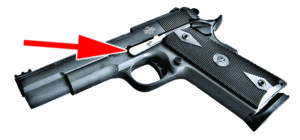
The magazine is a steel unit with a 14-round capacity. While it isn’t the highest capacity tested — the KelTec holds twice as many cartridges — that is a lot of ammunition. And we did say “magazine.” The pistol ships with a single magazine. Spare magazines remain difficult to impossible to find. We lucked into one in an odd way. A dealer we often patronize had these magazines on his wish list with his distributors for six months. The magazines arrived the day we picked up the KelTec in his shop. The Rock was actually found at another shop, and the Walther still another in a two-county area. We think we should have had a second magazine at the price or at least the chance to purchase spare magazines for less than the $60 going price. When looking online from June 2022 to August 2022, we were unable to locate a single XT 22 magazine to purchase. (True also of more common magazines.) Still, we were pleased to be able to test the pistol with two magazines. Bringing the Rock Island up to the two-magazine standard of the others makes it the most expensive pistol tested. The magazines are high quality and only slightly more difficult to load to capacity than the Walther.
The pistol was loaded with the same CCI loads to begin the test, and the magazine loaded in the same manner as the others. The first hang-up came with CCI’s 30-grain round. The nose hung up on the feed ramp. While this is a wide-open nose, the other pistols did not stutter with this load. We switched to 40- to 46-grain loads and enjoyed good feed reliability. The CCI 30-grain V-Max also fed well.
The pistol is motionless during firing. In fact, one rater used to bracing for heavier recoil sometimes pushed the pistol forward on firing. It isn’t a flinch, but the push must be overcome. The straight-to-the-rear trigger action breaks at 4.5 pounds, exactly the weight of the Walther’s trigger.
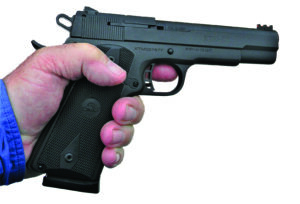
During the initial work up, we fired the pistol at human-silhouette targets at 7, 10, and 15 yards. This drill was followed with all three handguns. The Rock Island pistol was easily the fastest from the holster and to an accurate first shot hit, although the KelTec was very fast. The pistol provided good combat groups. However, the XT 22 was not 100% reliable. It failed to fully extract a spent cartridge on three occasions during the first 50 rounds. (We eventually fired 250 cartridges in this handgun.) We suffered three failures to fire due to light firing-pin strikes. One of our raters was able to fix the issues and get the pistol running. The solution was involved enough to make an article of its own. Some of it was cleaning, some tuning, a little breaking up an edge on the chamber.
Another issue was a failure to lock open on the last shot. We were able to lock the pistol open with the slide lock, but it never locked open on the last shot with any of the raters. We plugged in a Wilson Combat slide lock — no need for fitting — and this cured this problem.
This was an unfortunate combination of issues. The failure to extract was fixed, but it would have required a trip to the factory if we had not had a gunsmith on staff. Repair times are long these days. The failure to fire seemed to point to grease in the firing-pin channel. One rater noted he always cleans a pistol before firing, especially the trigger action. The failure to lock open on the last shot was a more involved fix that required a spare part from another 1911. None of these failures occurred with the other handguns.
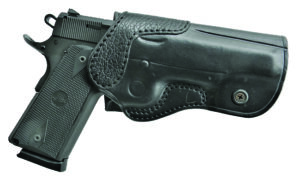
It is common enough for rimfire cartridges to misfire. This is one reason we do not recommend any rimfire for personal defense. Rimfire priming simply isn’t as reliable as centerfire. Just the same, the other two handguns spit out more than 600 spent cases with only one failure. The Walther seemed to whack a case rim hard enough, but the cartridge did not ignite. It cracked off on the second try. In contrast, the XT 22 had bona fide light strikes.
Our Team Said: In bench accuracy, the XT 22 proved to be an accurate gun on par with the KelTec but lagging behind the Walther. We enjoyed the pistol and its handling. The nagging extraction problems and light primer strikes were drawbacks even in a recreational handgun not destined for serious use. But some will rely on such a handgun on the trail or for self defense, and they’ll need a reliable handgun. It would take a lot of work for us to be confident in the Rock Island Armory XT 22 in these roles. Also, we considered that the pistol doesn’t have a light rail and isn’t optics ready as the other handguns are. Even our 1911 fan on the team would have preferred one of the other handguns. We’d have to pass on the XT 22.
22 WMR (22 Magnum) Range Data
We fired groups at 25 yards from a solid benchrest position using an MTM CaseGard K-Zone Shooting Rest. We used a Competition Electronics Pro Chrony to measure velocity. We placed the front screen of the chronograph 10 feet from the muzzles of the firearms.| Winchester Super-X 40-grain FMJ | Walther WMP | Rock Island Armory XT22 | KelTec PMr-30 |
| Average Velocity | 1260 fps | 1282 fps | 1249 fps |
| Muzzle Energy | 141 ft.-lbs. | 146 ft.-lbs. | 139 ft.-lbs. |
| Small Group | 1.1 in. | 2.0 in. | 1.6 in. |
| Average Group | 1.8 in. | 2.4 in. | 2.3 in. |
| CCI Maxi-Mag 40-grain JHP | Walther WMP | Rock Island Armory XT22 | KelTec PMr-30 |
| Average Velocity | 1421 fps | 1382 fps | 1330 fps |
| Muzzle Energy | 179 ft.-lbs. | 170 ft.-lbs. | 157 ft.-lbs. |
| Small Group | 1.5 in. | 1.8 in. | 1.6 in. |
| Average Group | 2.0 in. | 2.5 in. | 2.0 in. |
| Hornady Critical Defense 45-grain FTX | Walther WMP | Rock Island Armory XT22 | KelTec PMr-30 |
| Average Velocity | 1254 fps | 1293 fps | 1235 fps |
| Muzzle Energy | 157 ft.-lbs. | 167 ft.-lbs. | 152 ft.-lbs. |
| Small Group | 1.7 in. | 2.1 in. | 1.8 in. |
| Average Group | 2.1 in. | 2.6 in. | 2.2 in. |
Additional 22 WMR (22 Magnum) Velocity Data
| Load | Walther WMP | Rock Island Armory XT22 | KelTec PMR-30 |
|---|---|---|---|
| CCI VNT 30 grain | 1490 fps | 1433 fps | 1409 fps |
| CCI V-Max 30 grain | 1516 fps | 1550 fps | 1477 fps |
| CCI TNT 30 grain | 1568 fps | 1660 fps | 1498 fps |
| CCI Game Point 40 grain | 1401 fps | 1366 fps | 1345 fps |
| Armscor JHP 40 grain | 1310 fps | 1274 fps | 1299 fps |
Comparative 22 WMR (22 Magnum) Velocity
We used a Competition Electronics Pro Chrony to measure velocity. We placed the front screen of the chronograph 10 feet from the muzzles of the firearms.| Hornady V-Max | CZ 512 Rifle | Walther | Rock Island Armory | KelTec |
| 30-grain 83202 | 20.5-inch Barrel | WMP | XT 22 | PMR-30 |
| Average Velocity | 2371 fps | 1522 fps | 1539 fps | 1498 fps |
| CCI Maxi-Mag | CZ 512 Rifle | Walther | Rock Island Armory | KelTec |
| 40-grain JHP | 20.5-inch Barrel | WMP | XT 22 | PMR-30 |
| Average Velocity | 2260 fps | 1421 fps | 1382 fps | 1330 fps |
| Hornady Critical Defense | Heritage Revolver | Walther | Rock Island Armory | KelTec |
| 45-grain FTX | 6.5-inch Barrel | WMP | XT 22 | PMR-30 |
| Average Velocity | 1160 fps | 1254 fps | 1293 fps | 1235 fps |
| CCI Maxi-Mag | Heritage Revolver | Walther | Rock Island Armory | KelTec |
| 46-grain Segmented HP | 6.5-inch Barrel | WMP | XT 22 | PMR-30 |
| Average Velocity | 1201 fps | 1299 fps | 1257 fps | 1242 fps |



























Would RIA .22TCM be a better choice than the XT 22 mag? For about the same money it looks like more gun
Hey Walter: The 22 TCM is a centerfire round with more capability than the 22 WMR. Bigger case body, however, than the 22 Magnum, so magazine capacity is somewhat less. Ammo is much more expensive for the 22 TCM, and I believe 22 TCM is only loaded by one manufacturer, Armscor, the round’s developer. Todd Woodard